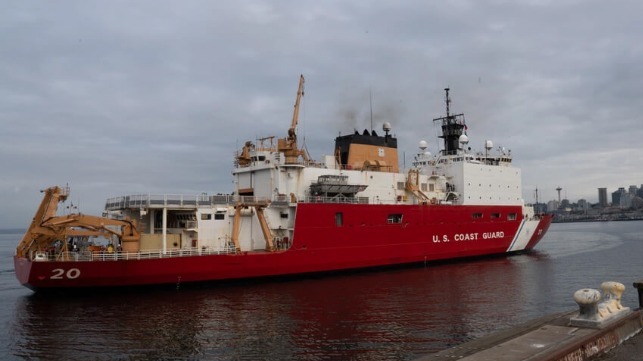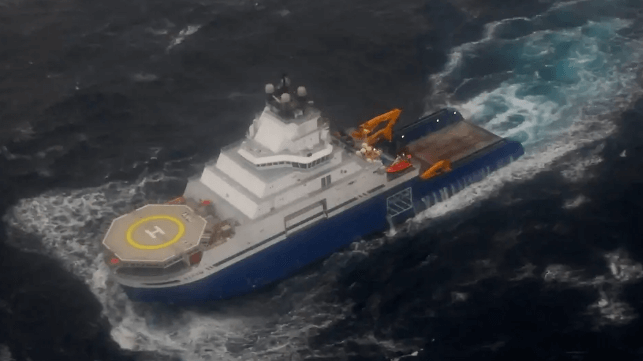USCG Polar Icebreaker Healy Returns to Seattle After Fire Suspends Mission

The U.S. Coast Guard’s polar icebreaker Healy returned to Seattle prematurely on August 16, approximately two months into her 2024 mission after having suffered a fire. The Coast Guard's statement is downplaying the incident saying that no one was injured, and the return is out of “an abundance of caution.”
The vessel deployed on June 13 on her mission which was planned for three stages. She was in the first phase, which called for her to operate in the Pacific and the Beaufort Sea, north of Alaska, and conduct a broad-scale survey of the boundary current system from the Bering Strait to the western Canadian Arctic.
The fire occurred the Coast Guard is confirming on July 25 while in the vicinity of Banks Island, Northwest Territories, Canada. The report says that the Healy’s crew and contractors restored power to the affected motor, but the cutter returned to Seattle to “ensure all redundant systems are fully operational before returning to the Arctic.”
In a written statement, Capt. Michele Schallip, Healy’s commanding officer said, “While transiting to a collection site, we suffered a fire on a transformer. I am immensely proud of the crew for quickly extinguishing the fire and limiting damage to that equipment.”
The Coast Guard is emphasizing that the Healy’s crew and embarked researchers conducted more than 150 conductivity, temperature, and depth (CTD) casts to investigate the circulation and properties of the water, monitored for signs of harmful algal blooms, and collected observations on marine mammals and birds in the Bering, Chukchi, and Beaufort Seas. Additionally, two subsurface moorings were deployed that are equipped with multiple sensors collecting oceanographic data on the physical, chemical, and biological state of the Arctic Ocean.
Leaving the Arctic means that the U.S. does not have a presence in the region during the critical research period while other countries are active there. The U.S. currently only has the Healy which is now 25 years old and the Polar Star which has been in service for 48 years and currently is undergoing a life extension overhaul. Construction of the next generation of polar icebreakers is significantly over budget and delayed and the USCG is moving toward acquiring and activating a commercial vessel, but it will not be in service till 2026.
Speaking in Washington, D.C. Coast Guard Admiral Kevin Lundy confirmed that the age of the Healy could make repairs difficult. He said that the equipment is “antiquated,” and that replacement parts were not readily available.
It is not the first time the Healy has suffered a life-threatening fire. In July 2020, she caught fire while 60 nautical miles off Seward, Alaska on her way to the Arctic. It was an electrical fire which was extinguished in 30 minutes, but one of her motors was badly damaged. She spent the winter of 2020-201 in dry dock receiving a new motor that had been built for her in 1999 and stored for over 20 years.
The Healy is designed to break 4.5 feet of ice continuously at three knots and can operate in temperatures as low as -50 degrees Fahrenheit. The USCG has not indicated if she can resume her mission. She was scheduled to embark 20 early career polar scientists and their mentors on a Polar Chief Scientist Training Cruise in the second portion of her 2024 mission and finally to support the Global Ocean Ship-Based Hydrographic Investigations Program (GO-SHIP), which aims to make the first ever single ship, single season, high-resolution transect of hydrographic observations across the Arctic basin.
U.S. Coast Guard Closes In on Purchase of Icebreaker Aiviq

The U.S. Coast Guard is closing in on the purchase of the privately-owned icebreaker Aiviq, and has formally confirmed that the vessel will be homeported in Juneau.
Aiviq was built in 2012 as an icebreaking anchor-handler, and she initially supported Shell's Arctic offshore drilling program. During a tow in Gulf of Alaska weather conditions in December 2012, she encountered seas of 20-30 feet and lost power in all engines due to water in fuel contamination. An after-accident inquiry found that this was likely caused by immersion of the low-freeboard stern and seawater infiltration through tank vents. Her tow, a unique ice-class drill rig, ran aground and was ultimately scrapped, and Shell suspended its Arctic drilling ambitions.
Aiviq was little-used for many years after the casualty, but has more recently operated as a charter vessel for Antarctic research. The owner has been open to leasing or selling the vessel to a government user since at least 2016, but the U.S. Coast Guard initially resisted, citing concerns over Aiviq's commercial design. Seven years later, facing rising maintenance challenges aboard its two active icebreakers, the Coast Guard received $125 million from Congress to buy the Aiviq as an interim solution.
After an 18-month period of vessel modifications, the Coast Guard plans to use Aiviq as a medium icebreaker for government service in Alaska and the far north. The vessel will take pressure off medium icebreaker USCGC Healy - which recently suffered a shipboard fire - and will fill in until the long-delayed delivery of the Coast Guard's new heavy icebreaker series, the Polar Security Cutters.
“As we continue to build the Polar Security Cutters, acquiring a commercially available polar icebreaker will enable the Coast Guard to increase our national presence in the Arctic, and homeporting this cutter in Alaska demonstrates the service’s steadfast commitment to the region," said Adm. Kevin Lunday, Coast Guard vice commandant.
The Aiviq's new homeport assignment will bring jobs and development to Juneau. The Coast Guard will bring in about 190 crewmembers for the vessel, and provisioning and maintenance will create economic activity. The service has already acquired a 2.4 acre plot of waterfront land from NOAA, and is expected to spend millions of dollars on building a homeport pier complex, with support from Alaska's congressional delegation.
No comments:
Post a Comment